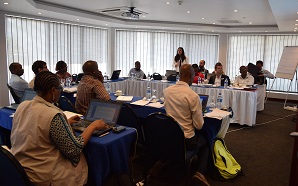 Demand is growing for the unique programme at UNEP DTU’s NAMAcademy. When it was launched in 2012, the academy’s six-day intensive course on Nationally Appropriate Mitigation Actions (NAMA) was held only once a year. In 2015, not only were there two resident courses onsite in Denmark, but also an in-country course in Mozambique.
Demand is growing for the unique programme at UNEP DTU’s NAMAcademy. When it was launched in 2012, the academy’s six-day intensive course on Nationally Appropriate Mitigation Actions (NAMA) was held only once a year. In 2015, not only were there two resident courses onsite in Denmark, but also an in-country course in Mozambique.
NAMAcademy offers week long intensive courses and private coaching to public officials and other project developers on the ins and outs of NAMA design and formulation. The classes aim not only at enhancing public officials’ capacity to develop NAMAs, but also teaching them how to structure their NAMA so that it is attractive to potential financers. Classes are taught by facilitators who have decades’ worth of experience in climate change negotiations and instruments. In order to insure that all participants start classes with a grasp of the basics, a free e-learning course is made available before the intensive onsite course begins.
As each course is tailored to participants’ needs, class content varies. The most recent resident course in Denmark (October 4 to 9) involved 10 participants from six different countries, who attended training on NAMA finance, Measuring, Reporting, and Verification (MRV), and measuring sustainable development, as well as sessions about waste management, efficient charcoal, wind energy, and low-carbon technologies for buildings.
This was also the first year that NAMAcademy went abroad. A three-day in-country training programme was held from September 22 to 24 in Maputo, Mozambique. Organized in cooperation with the Beligian government’s Climate Change Service, the course focused on developing NAMAs for the municipal waste and charcoal production sectors. Participants from eight different organizations attended the course, learning about the NAMA framework, finance, enabling conditions, and MRV.
The first day of training focused on the general NAMA basics, while the other two days were oriented towards more practical aspects of structuring finance and MRV. On the second and third days, participants were split into two groups, one for municipal waste, and one for charcoal production. Both groups learned about identifying potential NAMAs, finance options, and how to overcome the barriers to NAMA implementation in their sector. Finally, participants were invited to present their ideas for development. Six of the participants then came to the onsite course in Denmark in October (see above) to further develop their NAMAs.
As a result of the NAMAcademy in Mozambique, several ideas are being developed by the Mozambique government. From the charcoal sessions, a bioenergy NAMA is being developed for sustainable production and use of charcoal. From the sessions on municipal waste, three concepts are currently under consideration. The most developed so far is a NAMA for constructing waste transfer and recycling centers. In these centers, waste would be sorted so that organic matter could be composted and recyclable dry waste processed for sale. Another NAMA would use non-recyclable dry waste as an alternative fuel for cement plants. Finally, a NAMA is being developed for constructing sanitary landfills with technology for methane collection and lechate treatment.
For more information about the program and how to register for upcoming courses, please visit www.namacademy.org.